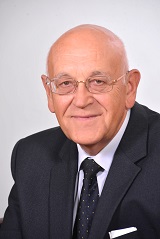К вопросам Шеметкова и Аграваля об обобщениях гиперцентра конечных групп
https://doi.org/10.29235/1561-2430-2024-60-4-271-279
Анатацыя
Формация F называется формацией Бэра – Шеметкова в классе групп X, если в любой конечной X-группе пересечение F-максимальных подгрупп совпадает с F-гиперцентром. Доказано, что для непустой наследственной насыщенной формации F существует наибольшая по включению наследственная насыщенная формация BSF, в которой F является формацией Бэра – Шеметкова. Установлена связь данного результата с решениями вопросов Аграваля (1976) и Шеметкова (1995). Для класса U всех сверхразрешимых групп описан класс BSU и приведен алгоритм распознавания принадлежности группы данному классу.
Спіс літаратуры
1. Baer R. Supersolvable Immersion. Canadian Journal of Mathematics, 1959, vol. 11, pp. 353–369. https://doi.org/10.4153/cjm-1959-036-2
2. Huppert B. Zur Theorie der Formationen. Archiv der Mathematik, 1969, vol. 19, no. 6, pp. 561–574. https://doi.org/10.1007/BF01899382
3. Šemetkov L. A. Graduated formations of groups. Mathematics of the USSR-Sbornik, 1974, vol. 23, no. 4, pp. 593–611. https://doi.org/10.1070/sm1974v023n04abeh002184
4. Shemetkov L. A., Skiba A. N. Formations of Algebraic Systems. Moscow, Nauka Publ., 1989. 256 p. (in Russian).
5. Hall P. On the System Normalizers of a Solvable Group. Proceedings of the London Mathematical Society, 1938, vol. 43, no. 1, pp. 507–528. https://doi.org/10.1112/plms/s2-43.6.507
6. Baer R. Group elements of prime power index. Transactions of the American Mathematical Society, 1953, vol. 75, pp. 20–47. https://doi.org/10.1090/s0002-9947-1953-0055340-0
7. Skiba A. N. On the F-hypercentre and the intersection of all F-maximal subgroups of a finite group. Journal of Pure and Applied Algebra, 2012, vol. 216, no. 4, pp. 789–799. https://doi.org/10.1016/j.jpaa.2011.10.006
8. Murashka V. I. On the F-hypercenter and the intersection of F-maximal subgroups of a finite group. Journal of Group Theory, 2018, vol. 21, no. 3, pp. 463–473. https://doi.org/10.1515/jgth-2017-0043
9. Murashka V. I. On Shemetkov’s Question about the F-Hypercenter. Mathematical Notes, 2024, vol. 115, no. 5, pp. 779–788. https://doi.org/10.1134/s0001434624050134
10. Beidleman J. C., Heineken H. A note of intersection of maximal F-subgroups. Journal of Algebra, 2010, vol. 333, no. 1, pp. 120–127. https://doi.org/10.1016/j.jalgebra.2010.10.017
11. Mazurov V., Khukhro E. I. (eds.). Unsolved Problems in Group Theory. The Kourovka Notebook, no. 20. Novosibirsk, 2022. Available at: https://arxiv.org/pdf/1401.0300 (accessed at 16 August 2024).
12. Vasil’ev A. F., Murashka V. I. Arithmetic graphs and classes of finite groups. Siberian Mathematical Journal, 2019, vol. 60, no. 1, pp. 41–55. https://doi.org/10.1134/s0037446619010051
13. Agrawal R. K. Generalized Center and Hypercenter of a Finite Group. Proceedings of the American Mathematical Society, 1976, vol. 58, no. 1, pp. 13–21. https://doi.org/10.1090/S0002-9939-1976-0409651-8
14. Weinstein M. (ed.). Between Nilpotent and Solvable. Passaic, NJ, Polygonal Publishing House, 1982. 231 p.
15. Monakhov V. S. Finite groups with a given set of Schmidt subgroups. Mathematical Notes, 1995, vol. 58, no. 5, pp. 1183–1186. https://doi.org/10.1007/bf02305002
16. Vasil’ev A. F., Vasil’eva T. I., Tyutyanov V. N., On the finite groups of supersolvable type. Siberian Mathematical Journal, 2010, vol. 51, no. 6, pp. 1004–1012. https://doi.org/10.1007/s11202-010-0099-z
17. Monakhov V. S., Kniahina V. N. Finite groups with ℙ-subnormal subgroups. Ricerche di Matematica, 2013, vol. 62, pp. 307–322. https://doi.org/10.1007/s11587-013-0153-9
18. Seress Á. Permutation Group Algorithms. Cambridge University Press, 2003. 264 p. https://doi.org/10.1017/CBO9780511546549
19. Höfling B. Computing projectors, injectors, residuals and radicals of finite solvable groups. Journal of Symbolic Computation, 2001, vol. 32, no. 5, pp. 499–511. https://doi.org/10.1006/jsco.2001.0477
20. Eick B., Wright C. R. Computing subgroups by exhibition in finite solvable groups. Journal of Symbolic Computation, 2002, vol. 33, no. 2, pp. 129–143. https://doi.org/10.1006/jsco.2000.0503
21. Murashka V. I. Formations of finite groups in polynomial time: F-residuals and F-subnormality. Journal of Symbolic Computation, 2024, vol. 122, art. ID 102271. https://doi.org/10.1016/j.jsc.2023.102271
22. GAP – Groups, Algorithms, Programming – a System for Computational Discrete Algebra. GAP. Available at: https:// www.gap-system.org (accessed at 16 August 2024).
23. Doerk K., Hawkes T. O. Finite Solvable Groups. De Gruyter Expositions in Mathematics, vol. 4. Berlin, New York, De Gruyter, 1992. 891 p. https://doi.org/10.1515/9783110870138
24. Eick B., Wright C. R. GAP package. FORMAT 1.4.4 Computing with formations of finite solvable groups. GAP. 2024. Available at: https://www.gap-system.org/Packages/format.html (accessed at 16 August 2024).
25. Guo W. Structure Theory for Canonical Classes of Finite Groups. Berlin, Heidelberg, Springer-Verlag, 2015. 359 p. https://doi.org/10.1007/978-3-662-45747-4
26. Kantor W. M. Sylow’s theorem in polynomial time. Journal of Computer and System Sciences, 1985, vol. 30, no. 3, pp. 359–394. https://doi.org/10.1016/0022-0000(85)90052-2
27. Babai L. On the length of subgroup chains in the symmetric group. Communications in Algebra, 1986, vol. 14, no. 9, pp. 1729–1736. https://doi.org/10.1080/00927878608823393









































